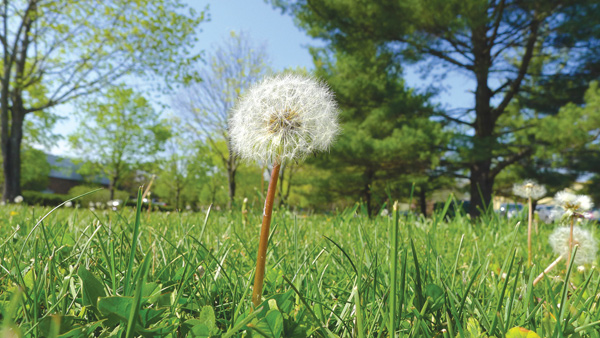Identification is key when dealing with ... Common weeds

A few common weeds are:
Common chickweed, which has a shallow root system, is often found in wet, shady grass and has leaves that are shiny and egg-shaped. Chickweed can also be identified by the lines of vertical hairs on the stem.
Corn Speedwell is a low-growing weed that thrives in weakened grass. The leaves on the lower part of the weed are rounded, and the upper leaves are smaller and pointed.
Henbit has a square stem that may appear purplish. The leaves are kidney-shaped and hairy. Henbit has leaves attached directly to the stem.
Purple Deadnettle has a purplish tinge and flowers in early spring.
Shepherd’s Purse has rounded leaves. It can be identified by the heart-shaped fruit produced in the spring. Shepherds Purse is often confused with the dandelion. It has white flowers, however, and the dandelion yellow flowers. Dandelion leaves come to a point toward the center of the rosette. When the leaves are pierced, the plant will exude a milk sap.
By LINDA DOLAK
OSU Extension Master Gardener Volunteer
Weeds are the most common pests in turf grass. They not only destroy the appearance of our grass, but also weaken it by stealing space, nutrients, water and light.
Weeds are more susceptible in the fall; therefore, fall applications of herbicide seem to work better. Also, fall applications are not affected by temperature as are spring applications.
Herbicides are just one of the tools in our toolbox of control options in our lawns.
Frequently, weeds germinate when grass coverage is poor due to excessive drought, winter injury, uncontrolled insect or disease infestation, or improper maintenance of the lawn.
Winter annual weeds normally germinate in September and October and die the following summer, whereas perennial weeds will reproduce by seeds and underground plant parts such as rhizomes and bulbs. Perennial weeds are more difficult to control, and will return the following year if not effectively regulated.
Herbicides are applied according to the stage of growth and the type of weeds. Pre-emergence herbicides are applied as the weeds germinate in the soil, whereas post-emergence chemicals are applied when the weeds are young and growing.
For suggestions on which herbicide you should use, check with your garden store or your local university extension through a fact sheet.
Homeowners should use Integrated Pest Management to decide which course of action to take.
The use of proper maintenance during the summer will help prevent the intrusion of winter annual broadleaf weeds in the fall.
To identify your weeds, visit http://go.osu.edu/lawnweeds. To get information on organic options, visit http://go.osu.edu/organiclawn.
 43
43

